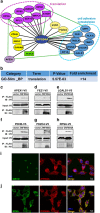Interactome analysis reveals ZNF804A, a schizophrenia risk gene, as a novel component of protein translational machinery critical for embryonic neurodevelopment
- PMID: 28924186
- PMCID: PMC5868632
- DOI: 10.1038/mp.2017.166
Interactome analysis reveals ZNF804A, a schizophrenia risk gene, as a novel component of protein translational machinery critical for embryonic neurodevelopment
Abstract
Recent genome-wide association studies identified over 100 genetic loci that significantly associate with schizophrenia (SZ). A top candidate gene, ZNF804A, was robustly replicated in different populations. However, its neural functions are largely unknown. Here we show in mouse that ZFP804A, the homolog of ZNF804A, is required for normal progenitor proliferation and neuronal migration. Using a yeast two-hybrid genome-wide screen, we identified novel interacting proteins of ZNF804A. Rather than transcriptional factors, genes involved in mRNA translation are highly represented in our interactome result. ZNF804A co-fractionates with translational machinery and modulates the translational efficiency as well as the mTOR pathway. The ribosomal protein RPSA interacts with ZNF804A and rescues the migration and translational defects caused by ZNF804A knockdown. RNA immunoprecipitation-RNAseq (RIP-Seq) identified transcripts bound to ZFP804A. Consistently, ZFP804A associates with many short transcripts involved in translational and mitochondrial regulation. Moreover, among the transcripts associated with ZFP804A, a SZ risk gene, neurogranin (NRGN), is one of ZFP804A targets. Interestingly, downregulation of ZFP804A decreases NRGN expression and overexpression of NRGN can ameliorate ZFP804A-mediated migration defect. To verify the downstream targets of ZNF804A, a Duolink in situ interaction assay confirmed genes from our RIP-Seq data as the ZNF804A targets. Thus, our work uncovered a novel mechanistic link of a SZ risk gene to neurodevelopment and translational control. The interactome-driven approach here is an effective way for translating genome-wide association findings into novel biological insights of human diseases.
Conflict of interest statement
The authors declare no conflict of interest.
Figures





Similar articles
-
Postnatal neurodevelopmental expression and glutamate-dependent regulation of the ZNF804A rodent homologue.Schizophr Res. 2015 Oct;168(1-2):402-410. doi: 10.1016/j.schres.2015.06.023. Epub 2015 Jul 8. Schizophr Res. 2015. PMID: 26164821 Free PMC article.
-
The Rat Homolog of the Schizophrenia Susceptibility Gene ZNF804A Is Highly Expressed during Brain Development, Particularly in Growth Cones.PLoS One. 2015 Jul 6;10(7):e0132456. doi: 10.1371/journal.pone.0132456. eCollection 2015. PLoS One. 2015. PMID: 26148198 Free PMC article.
-
Schizophrenia risk proteins ZNF804A and NT5C2 interact in cortical neurons.Eur J Neurosci. 2024 Apr;59(8):2102-2117. doi: 10.1111/ejn.16254. Epub 2024 Jan 26. Eur J Neurosci. 2024. PMID: 38279611 Free PMC article.
-
How might ZNF804A variants influence risk for schizophrenia and bipolar disorder? A literature review, synthesis, and bioinformatic analysis.Am J Med Genet B Neuropsychiatr Genet. 2014 Jan;165B(1):28-40. doi: 10.1002/ajmg.b.32207. Epub 2013 Oct 4. Am J Med Genet B Neuropsychiatr Genet. 2014. PMID: 24123948 Review.
-
The schizophrenia risk gene ZNF804A: clinical associations, biological mechanisms and neuronal functions.Mol Psychiatry. 2017 Jul;22(7):944-953. doi: 10.1038/mp.2017.19. Epub 2017 Mar 14. Mol Psychiatry. 2017. PMID: 28289284 Review.
Cited by
-
Genome-wide association study identifies locus at chromosome 2q32.1 associated with syncope and collapse.Cardiovasc Res. 2020 Jan 1;116(1):138-148. doi: 10.1093/cvr/cvz106. Cardiovasc Res. 2020. PMID: 31049583 Free PMC article.
-
Schizophrenia risk ZNF804A interacts with its associated proteins to modulate dendritic morphology and synaptic development.Mol Brain. 2021 Jan 14;14(1):12. doi: 10.1186/s13041-021-00729-2. Mol Brain. 2021. PMID: 33446247 Free PMC article.
-
ZFP804A mutant mice display sex-dependent schizophrenia-like behaviors.Mol Psychiatry. 2021 Jun;26(6):2514-2532. doi: 10.1038/s41380-020-00972-4. Epub 2020 Dec 10. Mol Psychiatry. 2021. PMID: 33303946 Free PMC article.
-
Convergent Evidence That ZNF804A Is a Regulator of Pre-messenger RNA Processing and Gene Expression.Schizophr Bull. 2019 Oct 24;45(6):1267-1278. doi: 10.1093/schbul/sby183. Schizophr Bull. 2019. PMID: 30597088 Free PMC article.
-
New literacy challenge for the twenty-first century: genetic knowledge is poor even among well educated.J Community Genet. 2019 Jan;10(1):73-84. doi: 10.1007/s12687-018-0363-7. Epub 2018 Mar 28. J Community Genet. 2019. PMID: 29589204 Free PMC article.
References
-
- Palmer BA, Pankratz VS, Bostwick JM. The lifetime risk of suicide in schizophrenia: a reexamination. Arch Gen Psychiatry 2005; 62: 247–253. - PubMed
-
- Cloutier M, Aigbogun MS, Guerin A, Nitulescu R, Ramanakumar AV, Kamat SA et al. The economic burden of schizophrenia in the United States in 2013. J Clin Psychiatry 2016; 77: 764–771. - PubMed
-
- O'Donovan MC, Craddock N, Norton N, Williams H, Peirce T, Moskvina V et al. Identification of loci associated with schizophrenia by genome-wide association and follow-up. Nat Genet 2008; 40: 1053–1055. - PubMed
Publication types
MeSH terms
Substances
Grants and funding
LinkOut - more resources
Full Text Sources
Other Literature Sources
Medical
Miscellaneous

